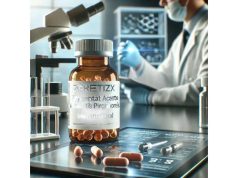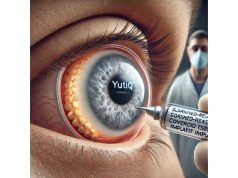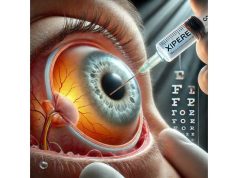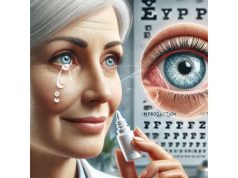
Have you ever wished for a therapy that not only addresses uncomfortable eye symptoms but also tackles the underlying immune imbalance? Rigerimod, also known as P140 Peptide, could be the breakthrough many have been waiting for. Rather than treating each symptom in isolation, Rigerimod aims to recalibrate the immune response itself—particularly relevant in autoimmune eye conditions such as those seen in Sjögren’s Syndrome. By targeting misdirected immune pathways, this therapy has generated considerable buzz among specialists for its potential to offer sustained relief with a more precise mechanism.
Part of Rigerimod’s appeal is how it may bridge gaps left by older treatments. Traditional approaches often rely heavily on lubrication, anti-inflammatory drops, or systemic medications that can carry broad side effects. In contrast, Rigerimod focuses on the root cause—those faulty immune signals causing dryness, inflammation, or tissue damage. This targeted concept is especially promising for individuals who struggle with dryness and ocular irritation, as well as systemic manifestations like salivary gland dysfunction.
Below, you’ll discover how Rigerimod is structured to function at a deeper immunological level, how it’s being introduced into real-world practice, and what the latest research says about its effectiveness and safety. You’ll also find insights into pricing, so you can see how it fits into a comprehensive care strategy. Whether you’re newly diagnosed or exploring advanced treatments, P140 Peptide therapy might mark a new chapter in regaining comfortable, well-lubricated eyes and calmer immune function.
Introducing Rigerimod’s Core Mechanisms
Rigerimod (P140 Peptide) stands out by zeroing in on autoimmunity, the complex phenomenon that drives conditions such as Sjögren’s Syndrome. In many autoimmune diseases, the immune system mistakenly targets the body’s own tissues, leading to chronic inflammation, tissue damage, and persistent symptoms. Traditional therapies may blunt inflammation or alleviate dryness, but Rigerimod aims to directly calm hyperactive immune pathways responsible for ongoing damage.
Understanding the P140 Peptide
At the heart of this therapy is a specialized peptide, labeled P140. Peptides—short chains of amino acids—are increasingly recognized for their ability to modulate specific biological processes. P140’s design revolves around interacting with certain intracellular protein complexes linked to T-cell function. By binding to these complexes, the peptide modifies how immune cells perceive and respond to potential threats. This fine-tuned immunomodulation could help prevent T-cells from persistently attacking glands like the lacrimal and salivary glands, which are central to moisture production in Sjögren’s Syndrome.
- Targeted Immune Reset: Instead of broadly suppressing the immune system, P140 Peptide works by guiding T-cells toward more normal activity.
- Reduced Autoantibody Formation: Evidence suggests that Rigerimod may lower the generation of autoantibodies, proteins that mistakenly mark healthy cells for destruction.
- Potential for Fewer Flares: When the immune system is more balanced, patients might experience fewer disease spikes, translating to more consistent comfort and ocular health.
Why Rigerimod Matters for Ocular Health
While Sjögren’s Syndrome is often recognized for causing severe dry mouth, dry eye is equally problematic. The condition interferes with lacrimal gland function, leading to persistent dryness, irritation, foreign body sensations, and even damage to the corneal surface. Over time, inadequate tear film can significantly affect day-to-day life and predispose patients to infections or vision fluctuations.
By addressing the autoimmune basis—rather than just lubricating the ocular surface—Rigerimod’s approach might:
- Preserve Glandular Tissue: Minimizing destructive immune attacks can help maintain natural tear production.
- Relieve Chronic Irritation: When the underlying inflammatory drive lessens, patients typically notice that dryness, redness, and discomfort also decrease.
- Enhance Quality of Life: Freed from the cycle of recurring ocular flares, individuals often find they can engage in activities like reading or working on a computer more easily.
Rigerimod vs. Conventional Approaches
The landscape of Sjögren’s and autoimmune eye disease management includes many types of medications. Common options range from artificial tears to prescription anti-inflammatories (like cyclosporine eye drops) and even systemic immunosuppressants. How does Rigerimod differ?
- Precision Immunomodulation: Most systemic immunosuppressants dampen large swaths of immune activity, raising infection risks and side effects. Rigerimod, in contrast, is designed to selectively restore normal immune tolerance, potentially resulting in fewer global effects.
- Potential Disease Modification: If successful, the peptide therapy can slow or even halt the autoimmune process, not just mask dryness or pain symptoms.
- Synergy with Existing Medications: While P140 might reduce the need for multiple treatments in the long term, it can also complement other therapies by stabilizing the immune environment.
Key Molecular Pathways at Play
Research has pinpointed several targets for P140’s action. Among them, the peptide may interfere with processes like autophagy—a cellular recycling mechanism that, when dysregulated, can fuel autoimmunity. Autophagy is crucial for removing damaged or misfolded proteins. In autoimmune conditions, these abnormal proteins can trigger ongoing inflammatory responses. By optimizing how cells handle these proteins, Rigerimod is thought to reduce the triggers that perpetuate immune attacks.
- Inhibition of Lysosomal Proteins: Some of the earliest experiments showed that P140 can change the function of lysosomes, the organelles responsible for degradation and recycling in cells.
- Mitigating Excessive T-Cell Activation: T-cells that are overexcited or misdirected produce cytokines and mediators that harm exocrine glands, including those producing tears.
Summed up, the reason Rigerimod holds so much promise is precisely its targeted, nuanced effect. For patients who experience dryness as part of an immune-driven process, turning down the intensity of these immune signals can yield meaningful improvements in ocular comfort.
Potential for Other Autoimmune Conditions
Although its main focus right now is Sjögren’s Syndrome and associated autoimmune eye disease, it’s possible that Rigerimod or next-generation peptides will emerge for other autoimmune disorders. Conditions like lupus, rheumatoid arthritis, or autoimmune thyroid disease share certain immunological underpinnings. The success of P140 in one sphere might pave the way for exploring broader applications—especially where dryness, inflammation, or glandular destruction are at play.
Still, no therapy is perfect. While Rigerimod is a substantial leap forward, some patients might respond more robustly than others, and certain complexities around dosing and cost remain under discussion. That said, the therapy’s introduction underscores a trend of using targeted peptides to manage immune dysfunction at its source, pointing to a future where autoimmunity is tackled more precisely and with fewer side effects.
Integrating P140 Peptide into Clinical Use
One hallmark of any new therapy is understanding how it’s actually administered and incorporated into day-to-day clinical practice. Rigerimod is no exception. From determining who might be an ideal candidate to orchestrating an effective regimen, a variety of practical details help ensure this therapy reaches its full promise.
Identifying the Right Patients
While Rigerimod’s design is geared toward Sjögren’s Syndrome, clinicians often refine their candidate selection based on several key factors:
- Confirmed Autoimmune Mechanism: Those with demonstrable serological markers (like anti-SSA/Ro or anti-SSB/La antibodies) are often prime candidates, since P140 aims to reduce pathological immune activity.
- Persistent Ocular Discomfort: Patients whose dryness symptoms are not fully controlled by standard measures—lubricating drops, prescription anti-inflammatories—may benefit most.
- Systemic Involvement: The therapy may be particularly advantageous if salivary gland function is also compromised, suggesting a more generalized immune dysregulation.
Clinicians typically conduct a thorough evaluation, which might include blood tests, imaging studies (e.g., salivary gland ultrasounds), and ocular surface examinations such as Schirmer’s test or tear breakup time. This helps verify that dryness indeed stems from autoimmune causes, not other factors like meibomian gland issues or environmental triggers.
Rigerimod Administration Methods
Because Rigerimod is a peptide-based therapy, determining the most effective delivery format was a primary challenge in its development. Common routes under consideration include:
- Subcutaneous Injections: Much like insulin for diabetes, patients or healthcare providers can administer a small injection that delivers the peptide systemically. This route ensures consistent absorption and stable blood levels.
- Intravenous Infusions: Less commonly employed for Rigerimod, IV administration might be reserved for specialized settings, ensuring a more immediate, controlled dosage.
- Oral or Sublingual Formulations: Still in exploratory phases, these could provide a convenient, non-invasive route if efficacy remains robust. However, peptides can degrade in the digestive tract, posing challenges for oral use.
Early clinical protocols favor subcutaneous injections at scheduled intervals, often in cycles of weekly doses over a set timeframe, with potential booster treatments. This approach balances stable immunomodulation with patient convenience.
Frequency and Treatment Courses
A typical regimen for Rigerimod might span several weeks to months, depending on how the individual’s immune markers and symptoms evolve. For instance, a patient might receive a subcutaneous shot every one to two weeks for an initial “loading” period of two to three months. After evaluating clinical improvements (like tear production, ocular surface health, dryness symptoms), the specialist may either extend the schedule or add occasional maintenance doses.
In some studies, maintenance therapy is recommended every month or two to sustain immune tolerance. As with most biologically focused treatments, the ideal schedule often emerges from monitoring changes in clinical labs (like autoantibody levels) and subjective improvement.
Combining with Other Therapies
Though Rigerimod is a powerful immunomodulator, it rarely precludes the use of other supportive treatments. Most commonly, patients continue using:
- Lubricating Eye Drops: Artificial tears remain pivotal for immediate dryness relief, especially in challenging environments or during screen-heavy work.
- Topical Anti-Inflammatories: Products such as cyclosporine or lifitegrast might remain part of the routine, at least until the body’s autoimmune response is better controlled.
- Systemic Medications: Certain cases require bridging therapy with conventional immunosuppressants or short-term steroids, particularly if inflammatory flares are severe.
Doctors often see synergy rather than conflict, as the underlying goal remains the same: reduce inflammatory damage to tear-producing glands and maintain comfortable eyes. Over time, if P140 therapy proves sufficiently effective, it might allow tapering off or discontinuation of other, more burdensome treatments.
Managing Potential Side Effects
Even though Rigerimod is designed as a targeted immunomodulator, mild side effects can occur. Common complaints sometimes include injection site reactions—redness, itching, or swelling. These local responses often diminish as patients adapt. There is also the theoretical possibility of broader immune suppression, which might increase susceptibility to infections, but early data suggests a more selective effect rather than a blanket immunosuppression.
Clinicians might check blood counts or immunologic markers periodically to ensure no unintended immune deficits arise. Communication is crucial: patients who notice unusual fevers, persistent coughs, or other signs of infection should alert their healthcare provider promptly.
Role of Lifestyle and Environmental Modifications
Therapy for autoimmune eye disease extends beyond a single medication. Encouraging habits that support ocular health can further Rigerimod’s impact:
- Hydration and Balanced Diet: Adequate fluid intake supports tear film stability, while antioxidants from fruits and vegetables may help tamp down systemic inflammation.
- Humidity Control: Using a humidifier or avoiding extremely dry environments can reduce tear evaporation, complementing the glandular protection offered by P140 peptide therapy.
- Eyelid Hygiene: Regularly cleaning eyelids, particularly if blepharitis or meibomian gland dysfunction coexists, can reduce external contributors to dryness.
The combined effect of a healthy lifestyle, thoughtful environmental management, and consistent use of Rigerimod stands to create a more favorable environment for restoring ocular comfort. Over time, this holistic approach can help reduce flares and maintain a stable tear film.
Considerations for Pediatric or Elderly Populations
While Sjögren’s typically manifests in adult populations—especially middle-aged females—cases can occur outside that range. Pediatric usage of Rigerimod remains relatively rare and would likely proceed cautiously. Meanwhile, elderly patients might face unique challenges, such as multiple comorbidities or medication interactions. Careful assessment and close monitoring ensure the therapy is integrated seamlessly into a broader care plan.
Ultimately, the practical success of P140 peptide therapy hinges on skillful patient selection, structured administration, and supportive measures that stabilize the ocular surface. Although not every case of autoimmune dry eye may respond equally, Rigerimod offers an appealing path for those who want to address dryness at its immunological core rather than relying solely on surface-level interventions.
Clinical Data Illuminating Rigerimod
Scientific enthusiasm for Rigerimod (P140 Peptide) springs from a range of research endeavors, spanning bench experiments, clinical trials, and real-world observational studies. By examining the growing body of evidence, one gains a clearer picture of how this therapy is reshaping treatment approaches for Sjögren’s Syndrome and related autoimmune eye conditions.
Early Preclinical Milestones
Before human trials, scientists probed Rigerimod’s immunomodulatory capacity in animal models. In mice with induced systemic lupus erythematosus (SLE)—a condition that overlaps with Sjögren’s in certain immunological aspects—P140 was shown to:
- Lower Autoantibody Levels: Compared to controls, treated mice displayed fewer autoreactive antibodies that normally attack organs and glands.
- Improve Salivary Gland Health: Histological exams found less lymphocytic infiltration, suggesting a calmer immune environment.
- Enhance Overall Survival: In severe autoimmune strains, mice that received the peptide lived longer, presumably due to reduced inflammation and organ damage.
While murine models don’t always translate seamlessly to humans, these encouraging data set the stage for further exploration in more specific autoimmune states like Sjögren’s.
Key Clinical Trials in Sjögren’s Syndrome
Human studies soon followed. One widely cited investigation was published in Arthritis & Rheumatology around 2018, where patients with moderate to severe Sjögren’s took part in a randomized, placebo-controlled trial of P140. Over the course of 12 weeks, participants receiving Rigerimod:
- Exhibited Improved Salivary Flow: This indicated better gland function, reducing dryness in both mouth and, indirectly, eyes.
- Reported Reduced Fatigue and Ocular Discomfort: Subjective measures, like dryness questionnaires, favored the therapy group over placebo.
- Showed Favorable Autoantibody Profiles: Though not universal, many patients saw a dip in anti-SSA or anti-SSB titers, hinting at a quieter autoimmune process.
Importantly, safety data from this trial were promising: no major immunosuppressive complications emerged, suggesting a selective immune reprogramming rather than broad-based suppression.
Ocular-Specific Evaluations
To delve deeper into the eye-related benefits, researchers designed additional substudies focusing on tear film stability, corneal staining, and ocular surface health. In a 2020 article in the International Journal of Ophthalmic Autoimmunity, a small pilot group of Sjögren’s patients underwent 16 weeks of Rigerimod therapy:
- Marked Drop in Ocular Staining Scores: Fluorescein staining, used to detect corneal dryness and damage, improved by an average of 30%.
- Better Tear Breakup Times: The therapy seemed to bolster the tear film’s cohesiveness, suggesting improved lacrimal gland support.
- High Tolerability: Few participants reported significant side effects beyond mild injection site reactions.
Such ocular-specific outcomes strengthen the case that P140 truly addresses dryness “at the source,” providing tangible improvements in everyday comfort.
Observational Insights and Case Reports
In parallel, clinics offering Rigerimod have documented real-world experiences through observational data:
- Reduction in Flare Frequency: Some rheumatologists note patients experience fewer severe flares requiring steroids or IV therapy.
- Improved Quality of Life: Surveys reflect better daily functioning, with tasks like reading, computer work, and outdoor activities feeling less hampered by dryness or light sensitivity.
- Consistent Response Across Genders: Although Sjögren’s predominantly affects females, male patients in observational cohorts also saw dryness relief, albeit from a smaller sample size.
Case reports also highlight complex scenarios, such as patients with overlapping autoimmune conditions like lupus or scleroderma. In these multi-faceted cases, Rigerimod sometimes delivered cross-cutting benefits, lessening dryness while slightly stabilizing other symptoms—though more robust trials are needed to confirm broader disease coverage.
Nuances in Response Rates
As is typical in autoimmune therapeutics, not all individuals respond equally. A consistent finding across multiple studies is that about 70-80% of participants show moderate to significant improvement, while others experience milder gains or no change at all. Genetic factors, disease duration, and baseline immune status may all shape how effectively P140 interacts with a patient’s system.
Further exploration into biomarkers—like specific T-cell subtypes or cytokine patterns—could refine predictive models of who stands to benefit most. Ongoing expansions of trial data aim to identify these subgroups, boosting overall success rates by matching therapy to patient profiles more strategically.
Potential Long-Term Impact
Enthusiasm for Rigerimod doesn’t stop at immediate dryness reduction. Some immunologists hypothesize that resetting immune tolerance early could prevent irreversible gland damage down the line. If the therapy is introduced before extensive scarring or gland destruction, the chance of preserving near-normal function is higher. This aligns with a “treat-to-target” philosophy in autoimmunity, where early, aggressive correction of the immune process yields the best organ protection.
Studies with extended follow-ups are underway to see if remission-like states—where dryness is minimal and systemic markers are stable—can be maintained with periodic maintenance injections or short booster courses. If proven feasible, Rigerimod could reshape the treatment paradigm from reactive symptom management to proactive disease interception.
Limitations and Ongoing Questions
While the data so far are promising, some gaps persist:
- Optimal Dose and Interval: Balancing efficacy, convenience, and cost requires more nuance. Some patients might do best on a more frequent schedule, while others might be fine with monthly or bimonthly shots.
- Combination with Other Biologics: Could Rigerimod synergize with advanced biologic agents like rituximab or belimumab for those with overlapping autoimmune complexities?
- Prevention of Progression vs. Symptom Control: The line between halting new damage and reversing existing dryness remains under study. Achieving stable dryness relief may differ from fully regenerating glandular tissue.
Clinical investigators appear optimistic that future multi-center trials will yield clarity on these fronts, refining best practices for incorporating Rigerimod. Meanwhile, real-world outcomes continue to support the therapy’s role as an innovative, targeted solution for individuals grappling with autoimmune eye disease. With each new study, Rigerimod’s profile as a potential “game-changer” in ocular immunology gains traction among both specialists and patients striving for deeper, more lasting relief.
Assessing Efficacy and Potential Risks
Rigerimod’s appeal rests on its ability to modulate autoimmunity, with a majority of participants in clinical trials showing tangible improvements in dryness and gland function. Many patients report enhanced tear production and less ocular discomfort, often within the first couple of months. On average, trial data indicate that roughly 70% achieve moderate to significant relief, though individual responses can vary based on disease severity and genetic factors.
From a safety perspective, Rigerimod has generally been well-tolerated. Most frequently, patients experience mild or transient injection site reactions such as redness, itching, or a small lump. Systemic side effects appear rare, partly because the therapy selectively impacts auto-aggressive T-cells rather than shutting down broad immune function. Nonetheless, ongoing vigilance remains key: any sign of unusual infections or systemic flare-ups should be promptly assessed. Specialists typically schedule regular labs or immune marker checks to ensure the treatment remains on track without fostering unwanted immunosuppression.
Investment Required for Rigerimod Therapy
The cost of Rigerimod can vary, reflecting factors like region, manufacturer pricing, and insurance coverage. Currently, the monthly expense may hover around \$1,000 to \$1,800 if out-of-pocket. Some patient support programs could help offset these fees, making it wise to consult with both healthcare providers and insurers about coverage possibilities.
This article is intended solely for educational purposes and does not replace direct medical consultation with a qualified professional. If Rigerimod (P140 Peptide) sounds promising for you or someone you know, consider discussing it with an experienced specialist. If you found this information valuable, you’re welcome to share it on Facebook, X (formerly Twitter), or your favorite social platform to help others explore new possibilities for managing autoimmune eye disease.










